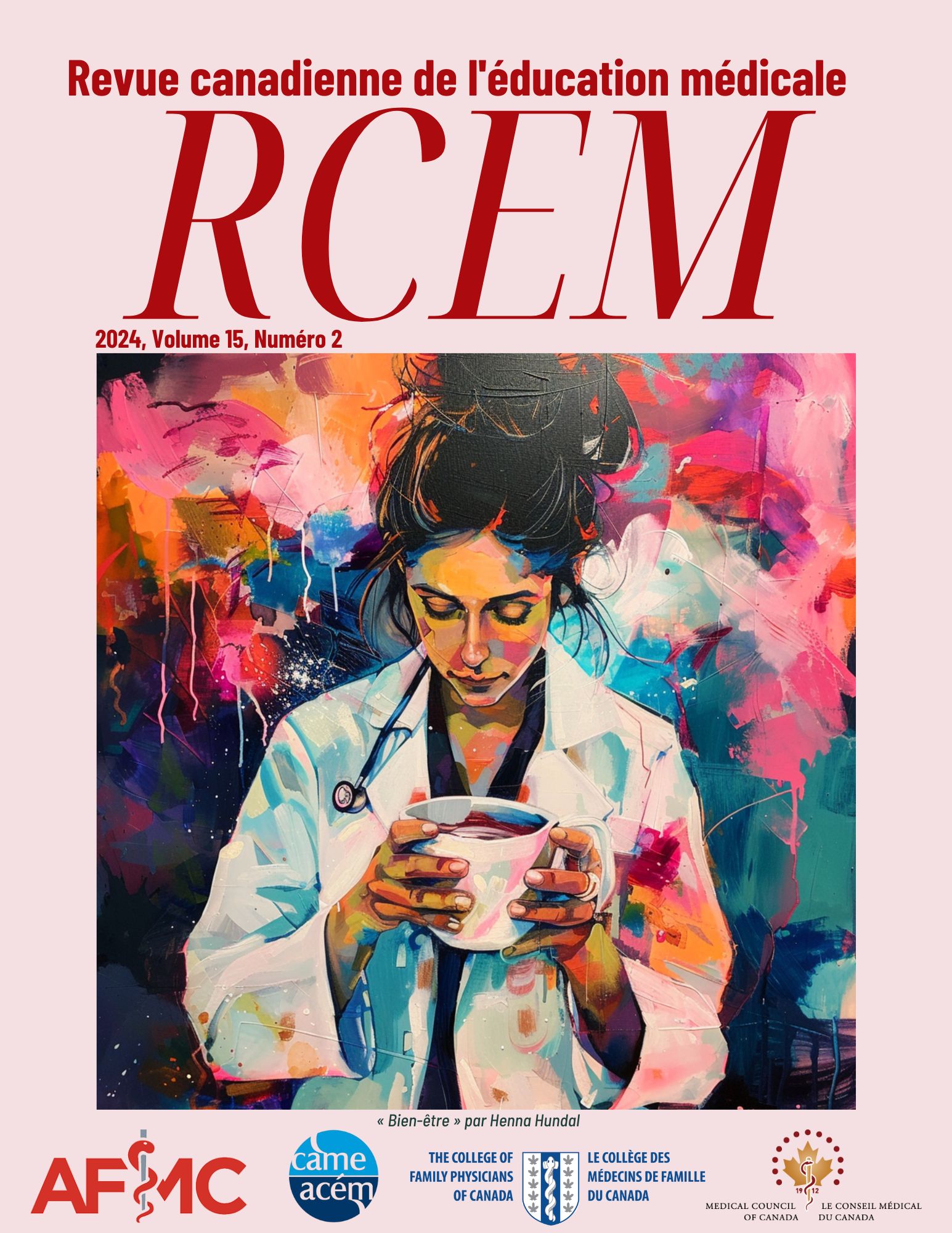Six stratégies pour bien cerner la notion de soins axés sur le patient et la famille pendant la formation médicale prédoctorale
DOI :
https://doi.org/10.36834/cmej.71342Résumé
Le lien entre les soins axés sur le patient et la famille et l’engagement des patients d’un côté et la qualité et la sécurité des soins, tant pour les patients que pour les prestataires de services, de l’autre, a été solidement démontré. Les attentes en matière de soins axés sur le patient et la famille ont évolué et elles ne se limitent plus à recueillir le point de vue du patient et à prendre en considération ses souhaits. On préconise désormais une approche participative faisant intervenir les patients en tant que partenaires dans leur cheminement clinique. Toutefois, certaines attitudes à l’égard des soins axés sur le patient et la famille freinent la mise en pratique d’une telle démarche. Dans les organismes de services de santé, le passage d’une approche centrée sur le système à un modèle de prestation de soins axé sur le patient et la famille constitue un terrain glissant. Nous proposons ici quelques stratégies pratiques pour aider les enseignants en médecine à faciliter l’acquisition par les étudiants des connaissances, des attitudes et des habiletés qui favorisent les soins centrés sur le patient et la famille.
Téléchargements
Références
Royal College of Physicians and Surgeons of Canada. CanMeds: medical expert [Internet]. 2015. Available from: http://www.royalcollege.ca/rcsite/canmeds/framework/canmeds-role-medical-expert-e. [Accessed on Sept 19, 2020].
Canadian Interprofessional Health Collaborative (CIHC). A national interprofessional competency framework. [Internet]. 2010. 1-32 p. Available from: http://ipcontherun.ca/wp-content/uploads/2014/06/National-Framework.pdf . [Accessed Sept 8, 2021].
Institute for Patient- and Family-Centered Care. Advancing the practice of patient- and family-centered care in hospitals: how to get started 2017. Bethesda, USA; p1-22. Available from: https://www.ipfcc.org/resources/getting_started.pdf. [Accessed on Oct 17, 2020].
Dagnone T. For patients’ sake: patient first review commissioner’s report to the Saskatchewan Minister of Health. Patient First. Saskatchewan Ministry of Health; 2009. Available at https://vibdoc.com/pf-commissioners-report.html [Accessed on Oct 8, 2021].
Parent K, Jones K, Phillips L, Stojan JN, House JB. Teaching patient- and family-centered care: integrating shared humanity into medical education curricula. AMA J Ethics 2016;18(1):24-32. https://doi.org/10.1001/journalofethics.2017.18.1.medu1-1601 DOI: https://doi.org/10.1001/journalofethics.2017.18.1.medu1-1601
Carman KL, Dardess P, Maurer M, et al. Patient and family engagement: a framework for understanding the elements and developing interventions and policies. Health Aff; 2013 Feb;32(2):223-31. https://doi.org/10.1377/hlthaff.2012.1133 DOI: https://doi.org/10.1377/hlthaff.2012.1133
Lloyd B, Elkins M, Innes L, Lloyd B, Elkins M. Barriers and enablers of patient and family centred care in an Australian acute care hospital: perspectives of health managers Patient exp j. 2018;5(3):9. https://doi.org/10.35680/2372-0247.1270 DOI: https://doi.org/10.35680/2372-0247.1270
Rivoire, E. Module 7a: patients as partners: engaging patients and families: patient and family centred care. Emanuel L, Taylor L, Hain A, et al., editors. Patient Safety Institute. 2017;p. 1-49. Available from: https://www.patientsafetyinstitute.ca/en/education/PatientSafetyEducationProgram/PatientSafetyEducationCurriculum/Pages/Engaging-Patients-and-Families-Patient-and-Family-Centred-Care.aspx. [Accessed Sept 28, 2021].
Doyle C, Lennox L, Bell D. A systematic review of evidence on the links between patient experience and clinical safety and effectiveness. BMJ Open. 2013 Jan 1;3(1):e001570. https://doi.org/10.1136/bmjopen-2012-001570 DOI: https://doi.org/10.1136/bmjopen-2012-001570
Teare GF, Keller M, Hall D. Bringing together research and quality improvement: the Saskatchewan approach. Healthc Q/ 2018 Jun 12;21(Special Issue):56-60. https://doi.org/10.12927/hcq.2018.25637 DOI: https://doi.org/10.12927/hcq.2018.25637
Illingworth R. What does "patient-centred" mean in relation to the consultation? Clin Teach. 2010 Jun;7(2):116-20. https://doi.org/10.1111/j.1743-498X.2010.00367.x DOI: https://doi.org/10.1111/j.1743-498X.2010.00367.x
Committee on Accreditation of Canadian Medical Schools (CACMS). CACMS standards and elements: standards for accreditation of medical education programs leading to the MD degree. 2020;(February 2019). Ottawa, Canada; p. 1-23. Available from: https://cacms-cafmc.ca/sites/default/files/documents/CACMS_Standards_and_Elements_AY_2021-2022.pdf [Accessed on Oct 8, 2021].
Institute for Patient- and Family-Centered Care. Applying patient- and family-centered concepts to bedside rounds. 2015. Bethesda, USA; p. 1-5. Available from: https://www.ipfcc.org/resources/PH_RD_Applying_PFCC_Rounds_012009.pdf. [Accessed Sept 22, 2021].
Institute for Patient- and Family-Centered Care. A checklist for attitudes about partnering with patients and families (part vi). 2017. Bethesda, USA; p.17. Available from: https://www.ipfcc.org/resources/getting_started.pdf. [Accessed on Oct 17, 2020].
Téléchargements
Publié-e
Comment citer
Numéro
Rubrique
Licence
© Krista Baerg, Tara Anderson, Heather Thiessen 2023

Cette œuvre est sous licence Creative Commons Attribution - Pas d'Utilisation Commerciale - Pas de Modification 4.0 International.
La soumission d’un manuscrit original à la revue constitue une indication qu’il s’agit d’un travail original, qu’il n’a jamais été publié et qu’il n’est pas envisagé pour publication dans une autre revue. S’il est accepté, il sera publié en ligne et ne pourra l’être ailleurs sous la même forme, à des fins commerciales, dans quelque langue que ce soit, sans l’accord de l’éditeur.
La publication d’une recherche scientifique a pour but la diffusion de connaissances et, sous un régime sans but lucratif, ne profite financièrement ni à l’éditeur ni à l’auteur.
Les auteurs qui publient dans la Revue canadienne d’éducation médicale acceptent de publier leurs articles sous la licence Creative Commons Paternité - Pas d’utilisation commerciale, Pas de modification 4.0 Canada. Cette licence permet à quiconque de télécharger et de partager l’article à des fins non commerciales, à condition d’en attribuer le crédit aux auteurs. Pour plus de détails sur les droits que les auteurs accordent aux utilisateurs de leur travail, veuillez consulter le résumé de la licence et la licence complète.











